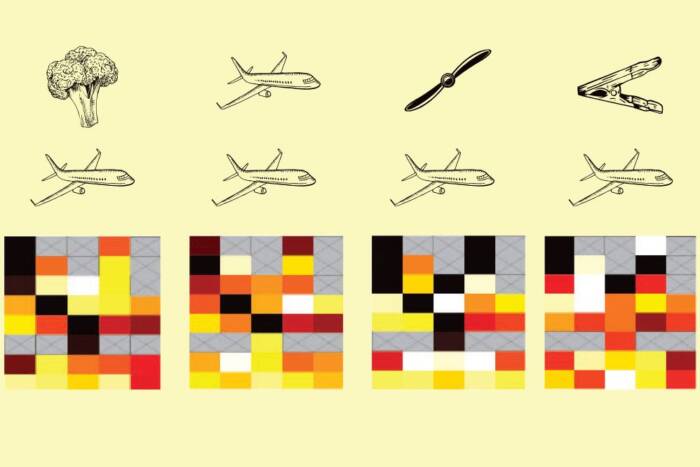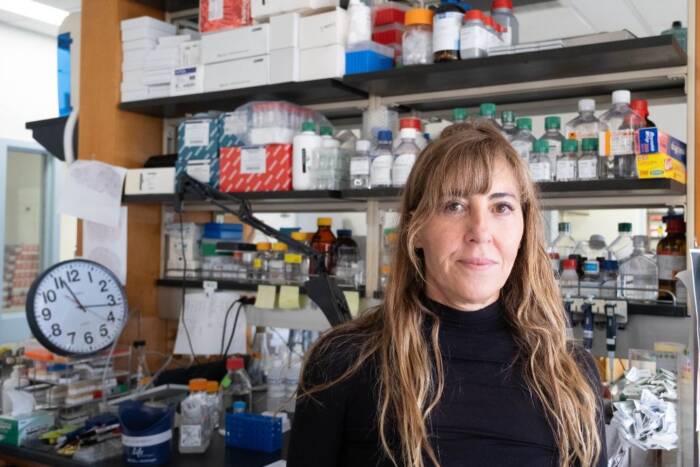For worms, positive thinking is the key to finding food
Caenorhabditis elegans, a tiny roundworm, spends much of its lifetime searching for soil bacteria to eat. This humble creature possesses 302 neurons, which may not seem like a lot compared to the billions of nerve cells that make up the human brain. Nonetheless, it uses sophisticated strategies to reach nutritionally promising places.
In a recent study, Rockefeller scientists have gained a new understanding about the neural processes that help a worm detect certain odor changes as it crawls and twirls, and use this information to find its way to a food source. The researchers described a neural circuit in the animal’s olfactory system that sends a message to the brain when the smell of food-related substances increases, nudging the animal in the right direction.

Onwards and upwards: A worm’s climb toward a food source is guided by olfactory signals, which activate a newly discovered neural circuit. In this diagram, bursts of this neural activity are shown as spikes on a heat chart.
According to senior author Cori Bargmann, Torsten N. Wiesel Professor and head of the Lulu and Anthony Wang Laboratory of Neural Circuits and Behavior(opens in new window), the worm’s brain derives surprisingly precise and simple information from these smell sensations. “There’s just one message,” she notes, “and it essentially says, ‘Life is getting better. Keep going!’”
The findings, which were published online in Cell Reports on September 10, cast new light on a fundamental question in neuroscience, concerning what happens in the brain in between sensory input and behavioral action.
“Animals receive very complex sensory information from our environment all the time — including smells, visual cues, sounds, temperature changes, and so on,” Bargmann explains. “But our brain isn’t merely reporting what our senses do. It actively seeks certain types of information, which it shapes and uses to drive behavior — and there’s a lot we don’t understand about these functions. For example, how does the brain know what sensory data is important at any given moment? How is this critical information extracted, and how does the brain act upon it?”
In humans and other mammals, myriad complicated steps lie between sensory perception and behavior. With its small and simple brain, C. elegans offers a more-manageable system for scientists to delineate these processes.
The worm is able to track an odor molecule called diacetyl, which is produced by some types of bacteria and smells like butter. (It is also a common food additive used to enhance the buttery tone of Chardonnay, or to coat popcorn with artificial butter flavor.) The molecule binds to receptors on C. elegans olfactory neurons, which signal to the brain’s olfactory bulb.
The researchers knew from earlier work precisely which of a worm’s 302 neurons are activated by diacetyl, and how these cells are interconnected. They also knew that the animal is able to locate a source of the molecule — say, a fragrant colony of E. coli — even in very small concentrations.
“In order to do this, the worm must somehow know where the highest peak of concentration is, and not stop until it reaches it,” Bargmann says.
The researchers worked in genetically engineered C. elegans in which activated neurons can be visualized under the microscope, and let the animals climb across diacetyl concentration gradients under carefully controlled conditions. Using advanced imaging and computational approaches, they were able to determine how the brain singles out and processes different pieces of olfactory information to regulate behavior.
“The C. elegans brain performs a calculation as direct and abstract as you could possibly imagine,” Bargmann says. “It only answers the question, ‘Are things increasing?’ It doesn’t distinguish very well between bigger and smaller increases, and it doesn’t pay attention to drops in diacetyl concentration.”
In re-running this simple computation over and over, the worm remains open to the possibility of finding higher and higher diacetyl concentrations. This might explain how it “knows” not to stop until the smell of food has reached its peak.
“The discovery of this neural mechanism shows us that this brain is more sophisticated in processing sensory information than we had perhaps realized,” Bargmann says. “Rather than solving specific problems, it senses phenomena changing over time and forms a dynamic idea of what this means. It’s a basic function that the brain performs that we didn’t previously recognize.”
 (opens in new window)Cell Reports 12, 1–13 (opens in new window)Cell Reports 12, 1–13A Circuit for Gradient Climbing in C. elegans Chemotaxis(opens in new window) Johannes Larsch, Steven W. Flavell, Qiang Liu, Andrew Gordus, Dirk R. Albrecht, and Cornelia I. Bargmann |


